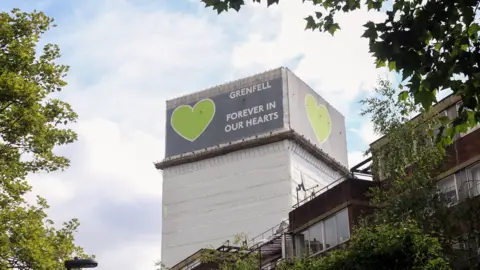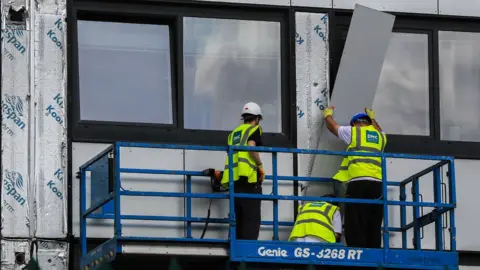Grenfell Tower: Fire test results before disaster missed - inquiry
 Getty Images
Getty ImagesA senior government building safety expert has told the Grenfell Tower inquiry catastrophic fire test results before the disaster "just got missed".
Brian Martin said he could not understand why the tests, from 16 years earlier, had not had more attention.
All five cladding systems tested by the government in 2001 failed to make the grade, he told the public inquiry.
Results were regarded as commercially confidential until the BBC revealed them last year.
In 2001 Brian Martin was one of three senior fire safety experts involved in the research project that commissioned the tests, while working for the Building Research Establishment (BRE).
However he also worked part of the week as the head of technical policy for building regulation in the government's housing department, now known as the Department for Levelling Up, Housing and Communities. He later joined the government full-time.
He is an important witness for the Grenfell Tower inquiry because at the time he was regarded as a key expert on the building regulation, who had the ear of senior government officials.
Mr Martin was said, at the inquiry, to have regarded the regulations covering building safety as like his "third child".
 PA Media
PA MediaHe was questioned repeatedly about why he failed to raise the alarm about the 2001 tests results, which revealed the risk of plastic and aluminium cladding.
Technicians had carried out a standard test, setting light to a 9m section of wall covered with cladding.
The resulting flames engulfed the test rig, leaping 20m into the air.
Mr Martin discussed what had happened with another expert, Dr Sarah Colwell, and admitted to the inquiry the tests demonstrated the "very real danger" of this type of cladding.
Giving evidence previously at the inquiry, Dr Colwell said the test was "catastrophic" and experts watching were "shocked".
However, the project's conclusion was that this simply needed "further consideration".
'Just got missed'
Mr Martin was asked by Counsel to the Inquiry, Richard Millett, why the response had been "feeble".
"I don't have an answer," he said.
While he accepted the government had been aware of the risks, he said the significance "just got missed".
"I don't understand how a result of that magnitude didn't get more prominence at the time," he said.
The results, marked "commercial in confidence" were circulated within some industry groups, but architects and building firms continued to install aluminium and plastic cladding on towers across England.
The first report on the Grenfell fire blamed the cladding for spreading the flames.
The plastic layer between the aluminium melted, dripped and set light to lower floors as well as allowing the flames to travel swiftly to the roof of the tower.
Residents died trapped in the flats by the flames and by the standing advice to "stay put".
Even after the Grenfell fire, and after the test report was unearthed by a colleague, it was not made public.
Mr Martin was asked, had he been "praying fervently that it wouldn't see the light of day?"
He said: "Tragically I think it just got forgotten and fell between the gaps."
The government responded to Grenfell by banning combustible cladding a year after the disaster, on the strength of new tests carried out after the fire.
Last year a summary of the 2001 tests was leaked to the BBC, revealing for the first time the true extent of the government's knowledge of the risks of combustible cladding.
The government has apologised to the victims of the Grenfell Tower fire and their relatives at the public inquiry.
The public inquiry continues.

You can follow the latest developments from the public inquiry on The Grenfell Tower Inquiry Podcast.
